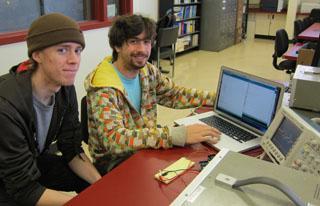
LEDing the Way to Optical Wireless Communication
You could say Will Cook and Dylan Rust, electrical engineering seniors, have seen the light. But when these two see light, they envision a method for transmitting data using light-emitting diodes (LEDs) and photodetectors within the visible and infrared frequencies of the electromagnetic spectrum. For their year-long capstone project, the pair is designing and testing an indoor wireless data distribution system that doubles as an energy-efficient lighting system with little to no ultraviolet radiation.
"The idea is that since radio waves are already in use within a certain bandwidth associated with data transmission, we can also have visible light operating in the same region without interference,” Rust explained. “Optical detectors work in the same way our eyes function by reading a light signal rather than a radiofrequency signal—just as our eyes recognize light, but our vision is not affected by radiofrequency waves."
Including this additional layer of connectivity is “like adding more lanes to the freeway to ease traffic—it may allow more information to flow at a speed that is potentially much faster,” Cook points out.
Much of their research is focused on determining where this type of system could be put to best use. “We’re gathering data on what size array would be needed to diffuse illumination in a room like an office without windows, the characteristics of the ‘noise’ produced by daylight in a room with windows or a semi-outdoor space, how much power is needed to provide enough light for the signal to overcome interference, and on what specific components will maximize the efficiency of the system,” they said, adding, “It takes a bit of guesswork and some helpful input from our advisor, Dr. Sarah Kate Wilson, but it’s looking good right now!”